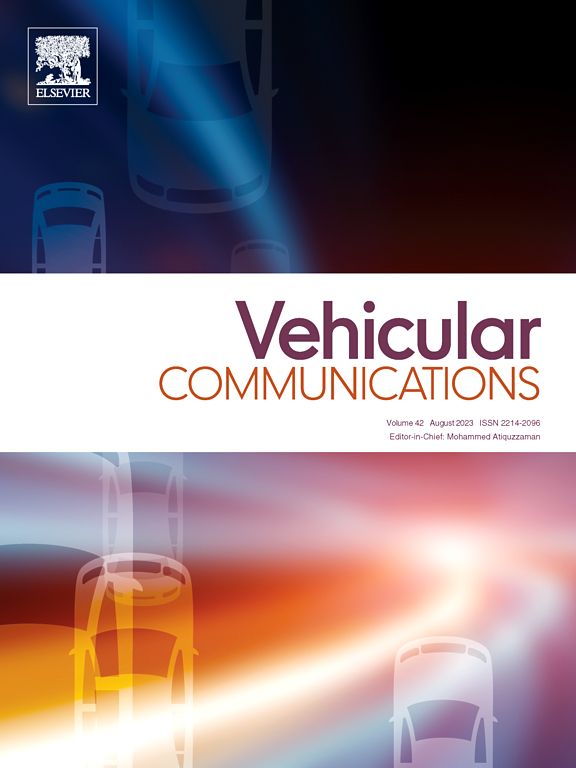Secure quantum aggregate signature scheme for vehicular ad-hoc networks
IF 6.5
2区 计算机科学
Q1 TELECOMMUNICATIONS
引用次数: 0
Abstract
The rapid evolution of smart cities and intelligent transportation systems has led to the widespread deployment of Vehicular Ad Hoc Networks (VANETs), enabling real-time inter-vehicular communication and data sharing related to traffic congestion, vehicle location, and road safety. However, the open and dynamic nature of VANETs makes them vulnerable to various security threats, including identity tracing and message forgery. To address these concerns, this paper proposes a quantum aggregate signature scheme that leverages quantum teleportation and untraceable identity mechanisms for secure and privacy-preserving communication in VANETs. The proposed scheme enables the aggregation of multiple signatures into a single, compact signature while preserving the anonymity of vehicular nodes through pseudo-identities and quantum-enhanced privacy techniques. By incorporating quantum teleportation, our scheme ensures quantum-level security for message transmission without directly transferring the secret state. Furthermore, it supports efficient batch verification to authenticate messages from multiple vehicles with minimal computational and communication overhead. The protocol's correctness and security are validated using both Scyther tool-based formal verification and informal analysis, demonstrating strong resistance against existential forgery, impersonation, and traceability attacks. Compared to existing schemes, our approach reduces computational time by 0.053 ms and communication overhead by 778 bytes, making it scalable, efficient, and highly applicable for real-world VANET deployments.
车载自组织网络安全量子聚合签名方案
智能城市和智能交通系统的快速发展导致了车辆自组织网络(vanet)的广泛部署,实现了与交通拥堵、车辆位置和道路安全相关的实时车际通信和数据共享。然而,vanet的开放和动态特性使其容易受到各种安全威胁,包括身份跟踪和消息伪造。为了解决这些问题,本文提出了一种量子聚合签名方案,该方案利用量子隐形传态和不可追踪的身份机制来实现vanet中的安全和隐私保护通信。该方案能够将多个签名聚合为一个紧凑的签名,同时通过伪身份和量子增强隐私技术保持车辆节点的匿名性。通过引入量子隐形传态,我们的方案在不直接传递秘密状态的情况下保证了信息传输的量子级安全性。此外,它支持高效的批量验证,以最小的计算和通信开销验证来自多辆车的消息。使用基于Scyther工具的正式验证和非正式分析验证了协议的正确性和安全性,展示了对存在伪造、冒充和可追溯性攻击的强大抵抗力。与现有方案相比,我们的方法减少了0.053 ms的计算时间和778字节的通信开销,使其具有可扩展性,效率高,并且高度适用于实际的VANET部署。
本文章由计算机程序翻译,如有差异,请以英文原文为准。
求助全文
约1分钟内获得全文
求助全文
来源期刊

Vehicular Communications
Engineering-Electrical and Electronic Engineering
CiteScore
12.70
自引率
10.40%
发文量
88
审稿时长
62 days
期刊介绍:
Vehicular communications is a growing area of communications between vehicles and including roadside communication infrastructure. Advances in wireless communications are making possible sharing of information through real time communications between vehicles and infrastructure. This has led to applications to increase safety of vehicles and communication between passengers and the Internet. Standardization efforts on vehicular communication are also underway to make vehicular transportation safer, greener and easier.
The aim of the journal is to publish high quality peer–reviewed papers in the area of vehicular communications. The scope encompasses all types of communications involving vehicles, including vehicle–to–vehicle and vehicle–to–infrastructure. The scope includes (but not limited to) the following topics related to vehicular communications:
Vehicle to vehicle and vehicle to infrastructure communications
Channel modelling, modulating and coding
Congestion Control and scalability issues
Protocol design, testing and verification
Routing in vehicular networks
Security issues and countermeasures
Deployment and field testing
Reducing energy consumption and enhancing safety of vehicles
Wireless in–car networks
Data collection and dissemination methods
Mobility and handover issues
Safety and driver assistance applications
UAV
Underwater communications
Autonomous cooperative driving
Social networks
Internet of vehicles
Standardization of protocols.
 求助内容:
求助内容: 应助结果提醒方式:
应助结果提醒方式:


